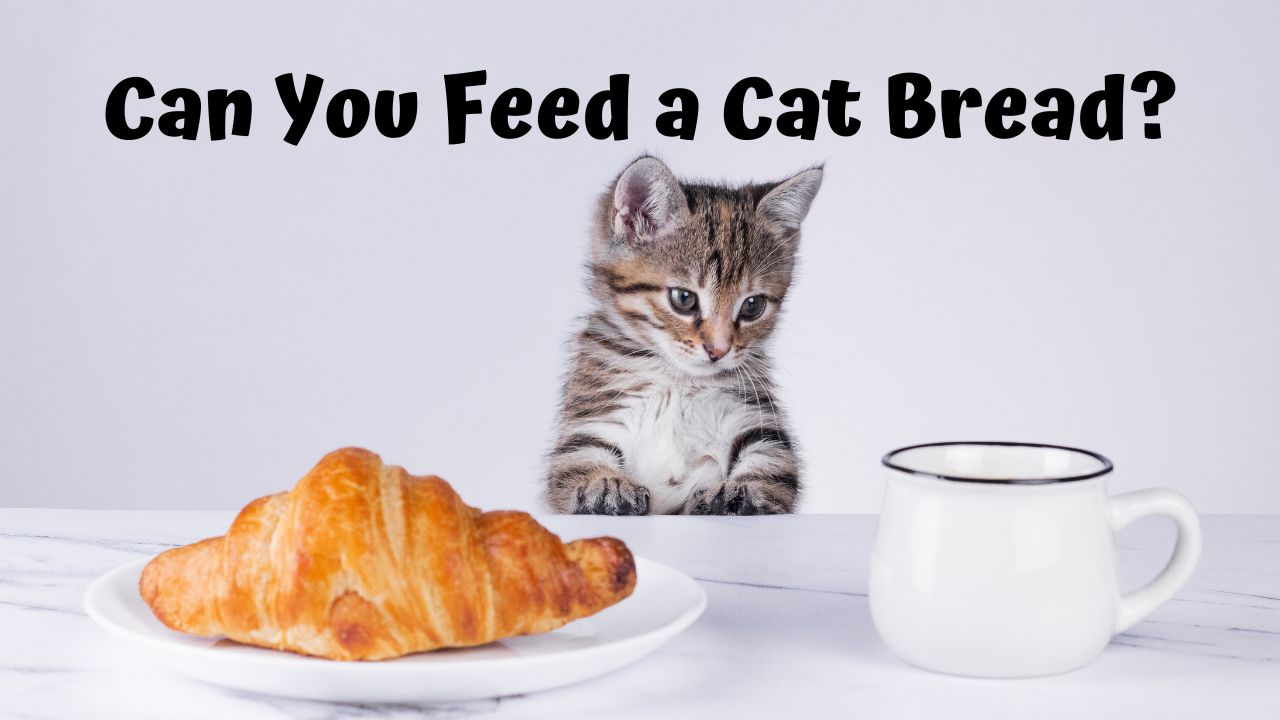Cat owners often ponder whether bread is a suitable treat for their feline friends. Felines are obligate carnivores, meaning their diet naturally revolves around animal protein.
However, many cat owners notice their pets are interested in human foods, particularly bread.
So that raises the question, can you feed a cat bread?
Cats can eat bread in small amounts, but it should not be a significant part of their diet. Bread doesn’t offer essential nutrients for cats and should be given as an occasional treat, not a regular meal.
Can You Feed a Cat Bread?
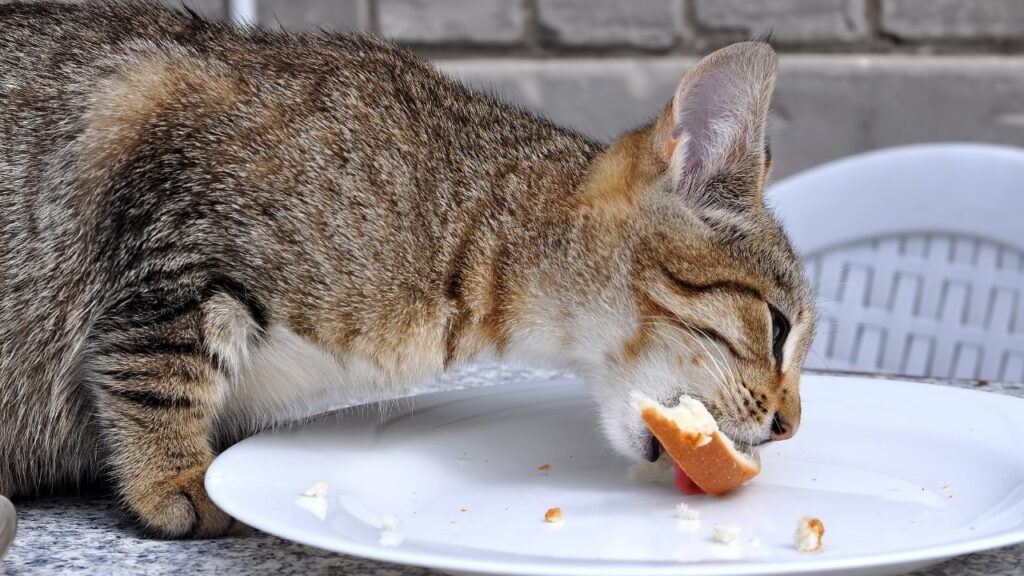
While a small piece of plain bread occasionally may not pose an immediate threat to a cat’s health, bread provides little nutritional value to a cat’s diet.
It’s essentially composed of empty calories that can contribute to weight gain if given in large quantities.
Moreover, certain types of bread, like garlic bread or bread with additional ingredients like raisins or nuts, can be toxic or cause allergic reactions in cats.
Ingredients such as garlic or onions are incredibly harmful and can lead to serious health problems, including blood abnormalities and digestive issues.
While small amounts of specific bread might be deemed safe, raw bread dough is particularly dangerous due to the presence of active yeast, which can cause alcohol poisoning and a distended stomach as it continues to ferment and release carbon dioxide gas within the cat’s stomach.
Introducing any new food, including bread, to a cat’s diet should be done cautiously. Consuming even small quantities of a new food can lead to stomach upset or allergic reactions.
Cat owners must weigh the potential risks and make an informed decision when considering feeding their cats any bread.
Balancing their diet with essential nutrients, typically found in commercial cat foods fortified with ingredients like taurine, remains the best way to maintain your cat’s health long-term.
Understanding Feline Nutrition
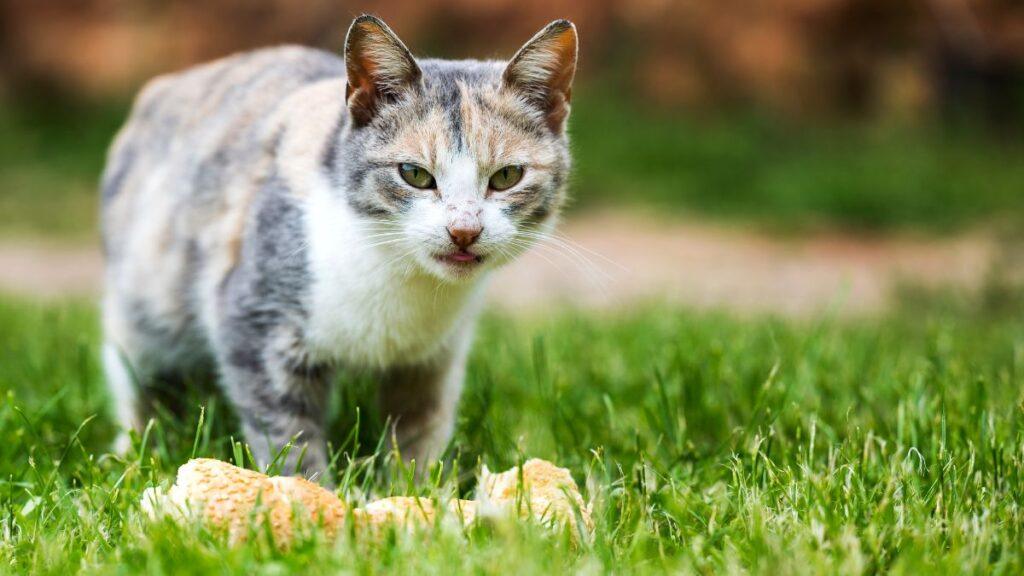
Cats have unique dietary requirements that are essential for their health and well-being. Recognizing these needs is crucial for any cat owner.
Obligate Carnivores and Their Diet
Cats are obligate carnivores, meaning their diet must principally consist of meat. They require a meat-based diet to obtain specific nutrients not readily available in plant-based foods.
Animal protein is crucial for cats as it provides them with essential amino acids, the building blocks of proteins that their bodies can’t synthesize sufficiently.
Taurine is a notable amino acid exclusive to animal protein and is vital for heart health, vision, and reproduction.
Meat Protein vs. Plant Protein in a Cat’s Diet:
| Protein Source | Utility for Cats |
|---|---|
| Animal Meat | Provides complete amino acid profile |
| Plants | Lacks certain essential amino acids |
An appropriate diet for a cat is focused on foods that are rich in meat proteins rather than plant-based proteins or carbohydrates.
Essential Nutrients for Cats
Cats need various essential nutrients to maintain optimal health. These include:
- Proteins: High-quality animal proteins like chicken, fish, or beef.
- Fats: Fats offer energy and help in the absorption of vitamins.
- Vitamins A and E are essential for a cat’s immune function.
- Minerals: Calcium and phosphorus are needed for strong bones and teeth.
Cats cannot convert beta-carotene from plants into vitamin A as efficiently as humans, making it essential to source this vitamin from animal-based foods.
Moreover, they require arachidonic acid, which is only found in animal fats.
Critical Nutrients and Their Sources for Cats:
- Amino Acids: Meat, fish, poultry
- Fatty Acids: Liver, fish oils
- Vitamins: Liver for vitamin A, fatty fish for vitamin E
- Minerals: Bones and meat for calcium and phosphorus
Meeting these nutritional needs is vital to prevent cat deficiencies and associated health issues. Ensuring that the diet satisfies the cat’s requirement for these essential nutrients supports long-term health and vitality.
Related: 25 Must-Watch Cat Documentaries of All Time
Bread and Cats

Cats may occasionally enjoy a small piece of bread, but it’s essential to understand which types of bread are safer and what risks are involved when including bread in a cat’s diet.
Types of Bread & The Effects on a Cat
Plain Bread:
- It is considered safe in small quantities for most cats.
- Lacks essential nutrients that cats need.
Garlic Bread:
- Toxic to cats due to garlic content.
- It can cause gastrointestinal upset and more severe health issues.
Banana Bread:
- Typically, it contains sugar and additional ingredients that are not ideal for a cat’s diet.
- It may also include harmful components like chocolate or raisins.
Nut Bread:
- Often high in fats and calories.
- Nuts can pose choking hazards or be toxic.
Wheat Bread:
- It is generally safer than white bread but not nutritionally beneficial for cats.
White Bread:
- It can spike a cat’s blood sugar and lead to weight gain.
- It is considered empty calories with little nutritional value.
Whole Grain Bread:
- Slightly more nutrients but still not a necessary part of a cat’s diet.
Multigrain Bread:
- Like whole grain, it may contain seeds or nuts, which should be avoided.
Peanut Butter:
- Sometimes added to bread, it could be high in fat and potentially contain xylitol, a toxic sweetener for cats.
When bread is considered “good” for cats:
- I am occasionally serving as a plain, small treat.
- Free from additional harmful ingredients.
When bread is “bad” for cats:
- It contains toxic or harmful components.
- Fed in large quantities or as a dietary staple.
Related: Are Cat Palms Toxic to Cats: A Clear Guide to Your Feline’s Safety
Potential Risks of Feeding Bread to Cats
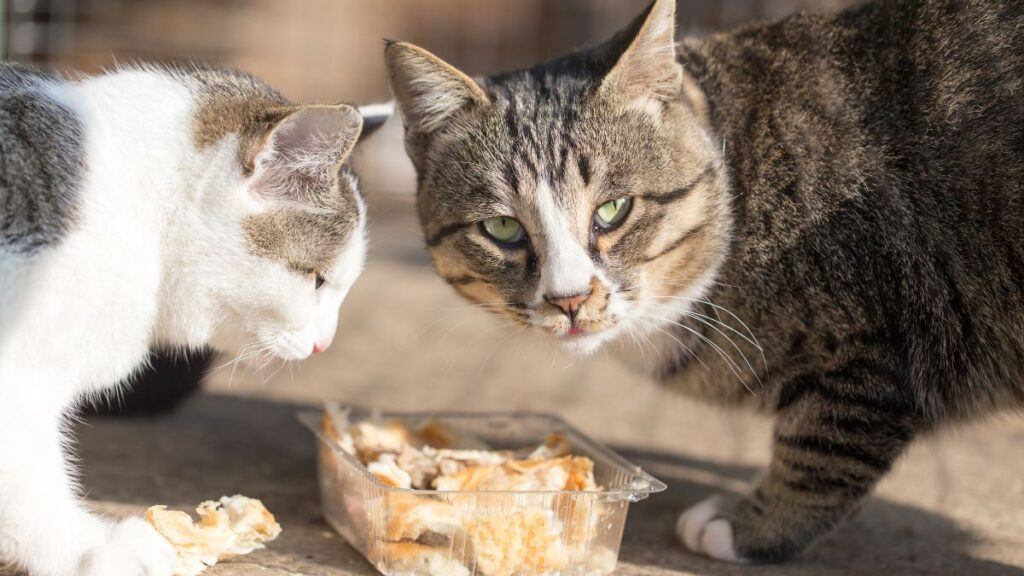
Health Problems from Ingredients:
- Garlic, onions, and nuts in bread can be toxic to cats.
- Additional ingredients like sugar and fats can lead to obesity and related health concerns.
Alcohol Poisoning from Raw Dough:
- Consumption of uncooked bread dough with active yeast can result in alcohol poisoning as the raw yeast ferments in the stomach.
Gastrointestinal Issues:
- Bread may cause upset stomach or constipation in some cats, especially if consumed in large amounts.
Nutritional Imbalance:
- Feeding bread regularly can lead to an imbalance of essential nutrients, as it does not meet a cat’s dietary needs for proteins and amino acids.
Choking Hazard:
- Large pieces of bread, nuts, or hard crusts can pose a choking risk.
Food Allergies:
- While not the most common allergen, some cats may have allergic reactions to wheat or other ingredients in bread.
Safe Practice:
- Introduce any new food, including bread, in tiny amounts to observe for any adverse reactions.
- Consult with a veterinarian before adding bread to a cat’s diet, especially if the cat has a pre-existing health condition.
Related: Are Dobermans Good with Cats: Understanding Feline-Canine Relationships
Health Considerations for Cats Consuming Bread
When considering bread as part of a cat’s diet, it is crucial to understand its nutritional implications and potential risks.
The following subsections provide an overview of the nutritional value of bread and highlight the risks of allergic reactions and toxic foods that may affect felines.
Nutritional Value and Empty Calories
Bread provides little to no nutritional benefit for cats, primarily because it lacks essential nutrients that felines require.
Cats are obligate carnivores, meaning their diet should be rich in animal protein and essential amino acids like taurine and arginine, which bread does not supply.
Instead, bread is often seen as a source of empty calories, contributing to weight gain and related health issues such as cat obesity.
Regular consumption of bread can also lead to a distended stomach or abdominal pain, especially if it is a significant part of the diet.
Allergic Reactions and Toxic Foods
While uncommon, some cats may experience allergic reactions to wheat or other grains found in bread, manifesting symptoms such as itching or gastrointestinal upset.
More concerning, however, are the toxic foods often associated with bread products like garlic or raisins in garlic bread or banana bread, which are harmful ingredients to felines.
Additionally, uncooked bread dough is dangerous because the active yeast can continue to ferment in the cat’s stomach, leading to alcohol poisoning and a potentially life-threatening distended stomach.
Persistent feeding of inappropriate foods, including bread with additional ingredients, can lead to serious health problems in the long term.
Related: Are Cat and Dog Years the Same? Debunking the Common Misconception
The Risks of Raw Dough
Introducing raw dough into a cat’s diet can lead to serious health complications due to the presence of active yeast and the potential for alcohol poisoning and digestive issues.
Alcohol Poisoning from Raw Yeast
When cats ingest raw bread dough, the active yeast within can cause alcohol poisoning. As raw yeast ferments in the warmth of a cat’s stomach, it produces alcohol as a byproduct.
Even small amounts of raw dough can pose a risk, as cats have a lower tolerance for alcohol, and their bodies are ill-equipped to process it. Symptoms of alcohol poisoning in cats include:
- Vomiting
- Diarrhea
- Disorientation
- Difficulty breathing
- Lethargy
The severity can escalate quickly, potentially resulting in coma or even death if not treated promptly.
Digestive Issues from Uncooked Bread Dough
The ingestion of uncooked bread dough can lead to significant digestive issues in cats.
The dough expands inside the cat’s stomach, potentially causing an upset stomach and a distended abdomen. This can further complicate more distressing conditions such as:
- Abdominal pain: A direct result of the expanding dough stretching the stomach lining.
- Blockages in the digestive system: If the dough hardens, it may create obstructions that are difficult to pass without medical intervention.
Given the sensitivity of a cat’s digestive system, even a tiny piece of raw dough can be harmful. Owners should ensure that uncooked bread dough is stored out of reach of their feline companions and avoid offering it as a treat.
Related: Cat Poop vs. Dog Poop: Navigating The Stinking Differences
Feeding Bread to Cats Safely
When considering bread as a treat for cats, it’s essential to focus on moderation and bread selection to ensure the safety and health of your feline friend.
Small Quantities and Occasional Treats
Feeding cats small amounts of bread can be relatively harmless if done infrequently. Bread should only be given as an occasional treat, not a regular part of the cat’s diet.
The best way to introduce bread is to start with a small piece of bread, as large quantities can lead to health issues such as weight gain and digestive discomfort.
- Safe Quantities: A bit of bread — a cube the size of a cat treat — can suffice.
- Frequency: Limit bread treats to once a week at most to avoid disrupting a balanced diet.
Choosing the Right Type of Bread
The type of bread is just as important as the quantity when feeding bread to cats. Not all bread is created equal, and some can be harmful.
- Plain Bread: Stick to simple, plain bread without additional ingredients like garlic or raisins, which can be toxic.
- Whole Grains: Opt for full grain or brown bread, as they are the best options for a small treat, providing more fiber and nutrients than white bread.
- Unseasoned and Unbaked: Ensure the bread is baked and does not contain active yeast, as uncooked bread dough can expand in a cat’s stomach, causing pain or more serious health issues like alcohol poisoning.
Bread should never replace the essential nutrients cats receive from their regular, meat-based diets. Constantly monitor your cat for any adverse reactions after introducing new foods, even in small quantities.
Long-Term Health and Nutrition
Maintaining a balanced diet is crucial for cats’ long-term health and well-being, requiring careful attention to nutritional needs and weight management.
Weight Management and Diet Control
Cats require a diet high in meat protein to sustain their health, as their bodies are designed for meat-based nutrition.
The average cat can experience weight gain if fed with excessive calories, leading to many health issues. Staple food for cats should primarily consist of commercial cat foods designed to meet their nutritional needs regularly.
- Essential Nutrients: Provide a diet that includes all essential nutrients.
- Weight Monitoring: Regularly check the cat’s weight to prevent obesity.
Health Conditions and Dietary Adjustments
Certain health conditions require dietary adjustments to manage symptoms and ensure a cat’s well-being.
For example, diabetes may necessitate careful monitoring of blood sugar levels, often involving changing the types of foods offered to affected cats.
- Symptom Management: Adjust the diet if the cat exhibits the following symptoms indicative of a health condition.
- Dietary Adjustments: Limit or include certain foods like dairy products based on the cat’s specific health condition.
- Professional Guidance: Consult a vet to make an informed decision about your furry friend’s diet.
Conclusion: Can You Feed a Cat Bread?
When considering the introduction of bread to a cat’s diet, it’s paramount to be well-informed about the potential impact on a cat’s health and to be vigilant about observing any changes in their well-being.
If this article helped you decide whether to feed your cat bread, please comment in the section below.
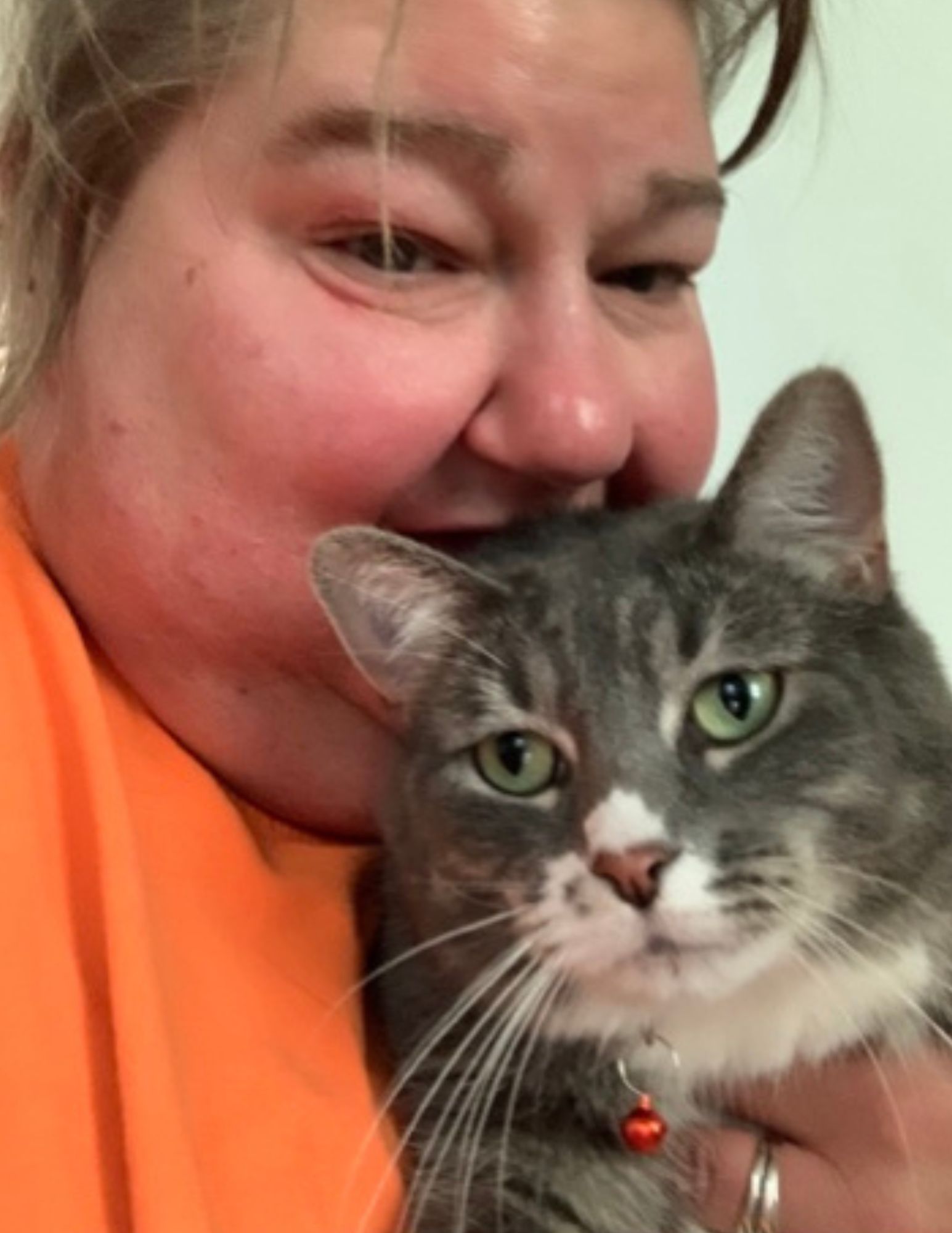
Meet Ann Haasnoot, the passionate founder of CatFurLife.com. A lifelong cat lover from Wisconsin, Ann combines her extensive feline behavior and care knowledge with her love for writing. On her website, she shares invaluable insights about cat breeds, care tips, and her experiences with her beloved furbaby, aiming to deepen the bond between cats and their human companions.

